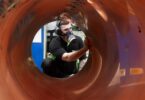When The Restory announced the resignation of its co-founders, Vanessa Jacobs, Thaís Cipolletta, Ferreira Alves and Emily Rea, with the prospect of its imminent failure, the future of fashion repair looked bleak.
Established in 2017, The Restory, led primarily by female founders, was considered a trailblazer. It was fashion’s leading luxury repair and aftercare service, with retail partners including Selfridges, Farfetch and Browns.
Forging new service sectors that swim against the prevalent tide need resilience. The Restory might have been the early sacrificial startup that paved the way – and lessons learned – for newer players. But if the economic rollercoaster of 2023 is anything to go by, market certainties right now are impossible to predict.
Whatever the impact of Restory’s demise, there’s a big problem we need to solve. Recent research from the Waste and Resources Action Programme warns that aggressive production levels by fashion companies are wiping out the positive impacts of sustainability initiatives.
Although brands committed to an environmental voluntary agreement (EVA) have improved on sustainability parameters, the rapid increase in textile production is cancelling out progress. The textile industry is one of the most polluting industries worldwide, as it generates over 10% of annual greenhouse gas emissions and is responsible for colossal water use.
As the global textile market is expected to grow by 7.6% annually this decade, it is crucial to reduce its environmental impacts to meet climate goals.
In its current form, the fashion industry largely operates using a linear model. Every year, more than 100 billion items of new clothing are made, yet 92 million tonnes of annual textiles waste is sent to landfill, in part because only 1% of textiles is currently recycled back into clothing. With the fashion industry contributing up to 10% of global carbon emissions, a report by the Ellen MacArthur Foundation calls for a transition to a circular economy, with new models of accessing clothes, including repair, rental and second-hand shopping.
On the flipside of the coin, it appears the appetite for clothing and footwear repair, re-use and recycling truly exists. A worldwide Deloitte survey reveals that 90% of 16-24 year olds plan to increase fashion recycling & purchase pre-loved items.
And yet, the volume of businesses serving repair needs is not huge or offering an extensive menu. Fashion brands have been slow to stitch repair into their customer services. And even when included, systemic repair is limited and customers can’t see enough easy choices.
However, it’s definitely not a fog of despair.
We can celebrate that reuse and resale behaviour through the likes of the DePop app have struck fire with younger Gen-Z shoppers. And this doesn’t feel like a fashion blip. With CEO Kruti Patel Goyal at the helm of Depop since July 2022, the business has increased sales to £54.3million.
But if we want to reduce emissions and the disastrous effects of global warming, we really need behaviour to change towards repair and retain.
Recent research by Wiedemann et al. found that if the number of wears increased by 50%, the climate change impacts of all natural fibres would be negative.
That is, greenhouse gas emissions would be avoided entirely because emissions associated with the manufacture of a new petro-PET garment would be averted’. And according to Leather UK, garments made from long-lived, natural materials can have an undeniably positive action in reducing the climate impact of fashion and textiles.
There is a slow step change. Repair is emerging as a steady but growing industry.
This article aims to spotlight 5 champions of the repair, re-use and recycling industry. The global players. The trade bodies. The campaigners. The partnerships and the small studios. And the fact that many of the leaders in the repair and recycle industry are women? Something additional to celebrate.
So Who Is Leading Fashion Repair?
1.The Seam – merging the world of technology with makers
For most of her life, Layla Sargent had her clothes altered and repaired by her grandma, a professional dressmaker for over 60 years. After moving to London, Layla realised how difficult it was to find a local, trusted maker with specialist skills to care for her clothes.
In 2019, Layla conceptualised and founded The Seam, merging the world of technology with London’s Maker network, with a vision of making clothes care & repair services accessible to everyone.
This on-demand tailoring service, founded by Layla Sargent in 2019, has just launched partnerships with Net-a-Porter, Mr Porter and The Outnet. Alison Loehnis, ad interim CEO of Yoox Net-a-Porter, says it “is designed to ensure that the pieces our customers buy from us can be cherished for years to come”. After a virtual consultation, The Seam connects users with local dressmakers and tailors, with prices starting from £3 and most services completed within 10 days.
Layla is excited to soon scale The Seam services to her hometown, Birmingham, so that she can get her nan signed-up as a Maker on the platform.
2.Sojo London – tailoring, altering and repairs
This fashion tech platform and app was started by 25 year old entrepreneur, Josephine Philips in 2021.
The door-to-door service includes repairs and alterations for individuals and brands (to reduce returns). Sojo has recently acquired zero-emissions courier Spedal as a logistics partner, so a quick zip fix can now be conducted guilt-free.
‘Fashion needs a new fit. One where the people who make clothes are paid enough to live and in turn our clothes live longer too.
Where our style impacts the way we live and feel. Not the planet. Where the things we buy stay in our wardrobe……and don’t bounce from shopping cart to landfill’
The business offers aB2B and B2C service with a team of talented and creative tailors who are committed to providing high-quality repair and alteration services – collected from and delivered from the door.
3.It’s A Long Story – a spotlight on the repair and longevity of leather
Recently spearheaded by Debbie Burton, Chair of Leather Naturally – in collaboration with The Prospect Society, It’s A Long Story is the world’s first digital exhibition that spotlights the role of leather in a sustainable future.
The exhibition shares a perspective on the long lasting qualities of leather and offers a range of brand, designer and personal stories through films, imagery and interviews.
Essays from supporters including Anya Hindmarch (who designed a world first compostable leather for her ‘Return To Nature’ collection), Suzie Williams (aka The Repair Shop) and furniture designer, Bill Amberg all help tell the story of the unique longevity of leather.
And established and new brand designers champion the qualities of leather including Ecco, Coach, Schott NYC, Dents gloves and leather repair services including the recently launched collaboration between Dr Martens and The Boot Repair Company.
Consumers are invited to share their own personal stories of well loved and well worn leather treasures. As an educational and inspiring platform about the long lasting qualities of leather – it’s a winner.
Global luxury fashion house LVMH recently awarded its 2023 Innovation Award to repair platform Save Your Wardrobe (SYW), a London-based startup that connects store representatives with tailors, cobblers and restorers to fix clothing, shoes, jewellery and bags.
“Save Your Wardrobe perfectly illustrates our ambition in creative circularity, a pillar of our environmental roadmap, Life 360,” Bernard Arnault, chairman and CEO of LVMH said in a statement.. “I am convinced that their solution will very quickly resonate with the aspirations of our maisons and the expectations of our customers.”
Founded in 2017 by Tunisian female entrepreneur Hasna Kourda, SYW can be integrated in store, online or with brands’ existing CRM. The platform is able to onboard in-house service providers or leverage its network of clothing care specialists. It currently works with an ecosystem of artisans in Germany, UK, France and the US (with the plan to expand to the Middle East, South Korea and Japan).
The startup will be onboarded at La Maison des Startups LVMH, the group’s business acceleration programme, within Paris incubator Station F from September 2023 for a year.
5.Anya Hindmarch & Toast
Putting these two pioneering brands together. Not just spotlighting the unique repair services offered at Toast but also the innovative compostable leather designed by Anya Hindmarch.
TOAST Repair is a free mending service that brings new life to worn TOAST garments. Bring any TOAST clothing item in need of repair to one of their shops and discuss mending options with a TOAST Shop colleague.
If you are able to visit TOAST Bath, Edinburgh, Harrogate, London Notting Hill, London Shoreditch or Oxford you have the opportunity to spend time with a repair specialist to discuss creative mending options, learning the best approach for extending the lifespan of your garment.
Shop colleagues or repair specialists will share their knowledge on invisible and visible mending, from Sashiko repair, darning and patching to appliqué, before selecting the technique best suited to the fabric and type of repair for your item of clothing.
Using these traditional techniques, many of which are sewn by hand, will extend the life of your garment for years to come. By taking the time to restore a well-loved item and highlight its worn areas, we can rethink our relationship with clothing.
Anya Hindmarch’s Return to Nature was inspired by the words of environmentalist and sustainability consultant Arizona Muse, and now supports her charitable organisation, Dirt, the foundation for the regeneration of the earth. For every bag sold, up to £10 will be donated to the independent organisation.
Challenged by the idea of a zero-waste future, and inspired by the circularity of nature, the vision for Return to Nature took two years to realise.
The journey to create this collection of bags involved seeking out tanneries who could offer fully traceable skins, tracking down craftspeople who have developed pioneering tanning and finishing methods, and finding ways to make straps adjustable and bags secure without using any hardware.
The leather used in the Return to Nature collection uses a pioneering tanning and finishing method, developed with Richard Hoffmans (est. 1899) and Nera Tanning, resulting in a product that is chrome, heavy-metal and aldehyde-free – and thus able to biodegrade and compost.







